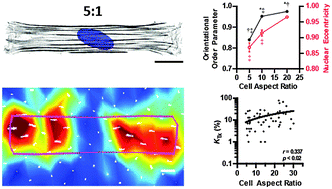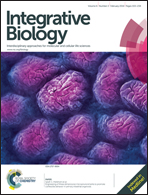The contractile strength of vascular smooth muscle myocytes is shape dependent†
Abstract
Vascular smooth muscle cells in muscular arteries are more elongated than those in elastic arteries. Previously, we reported changes in the contractility of engineered vascular smooth muscle tissue that appeared to be correlated with the shape of the constituent cells, supporting the commonly held belief that elongated muscle geometry may allow for the better contractile tone modulation required in response to changes in blood flow and pressure. To test this hypothesis more rigorously, we developed an in vitro model by engineering human vascular smooth muscle cells to take on the same shapes as those seen in elastic and muscular arteries and measured their contraction during stimulation with endothelin-1. We found that in the engineered cells, actin alignment and nuclear eccentricity increased as the shape of the cell elongated. Smooth muscle cells with elongated shapes exhibited lower contractile strength but greater percentage increase in contraction after endothelin-1 stimulation. We analysed the relationship between smooth muscle contractility and subcellular architecture and found that changes in contractility were correlated with actin alignment and nuclear shape. These results suggest that elongated smooth muscle cells facilitate muscular artery tone modulation by increasing its dynamic contractile range.


 Please wait while we load your content...
Please wait while we load your content...